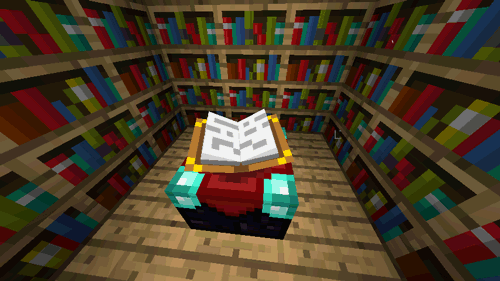Now with added freedom!
Hello! Welcome to ConstitutionCraft, where we take a closer look at the materials and recipes that went into crafting the Constitution of the United States. We have the different sections of the Constitution described on the pages linked to the left. Below we have a little background information on the constitutional convention where the Founding Fathers made all the hard decisions about building our government.
What our founders tried first.
Did you know that before the founding fathers built our current United States Constitution they ran the country under a set of rules called the "Articles of Confederation?" The people that put together and adopted the original rules were called the Continental Congress. The states themselves were considered separate and independent of each other while the confederation was just a basic agreement to work together as friends. James Madison and other founding father's thought that the country needed a more formal central government to help the states settle arguments across state lines. They also were worried about the ability of the states to defend our new nation against outside threats from other countries. It was decided to have a constitutional convention in order to make a new set of rules for the government of the United States. In May of 1787 a group of delegates met and started to debate the proper way to run the government of the new country they had helped form.
Arguments AND contention; liberty OR oppression.
Alexander Hamilton thought that a strong central government would provide for a more easily run country. James Madison was in favor of a stronger federal government, he was worried that the existing rules for the Confederation government did not have any power to regulate commerce. Commerce is the exchange of money for services or goods.
 Other founders were worried about putting too much power into a central government. One of the opponents of creating a new constitution was Patrick Henry. Patrick Henry was one of the most famous revolutionary war leaders. He is best known for his statement, "Give me liberty, or give me death!" When he said that he meant that a life without freedom and liberty to choose one's own path is as bad as being dead. The state of Rhode Island was so against the idea of a Constitutional Convention to change the government that they refused to attend the convention all together!
Other founders were worried about putting too much power into a central government. One of the opponents of creating a new constitution was Patrick Henry. Patrick Henry was one of the most famous revolutionary war leaders. He is best known for his statement, "Give me liberty, or give me death!" When he said that he meant that a life without freedom and liberty to choose one's own path is as bad as being dead. The state of Rhode Island was so against the idea of a Constitutional Convention to change the government that they refused to attend the convention all together!
It is important to remember that the founding fathers had just fought a long and difficult war with the British to obtain freedom for the United States and all the people within our country. The British Parliament and King George III had been changing the rules constantly for the colonies without the citizens here having any say in the changes being made. Taxes were charged on everyday items and then laws were passed to make it illegal for those items to be brought to the United States by anyone other than specially authorized traders from the British Empire. You might remember the tale of the Boston Tea Party where a number of Boston citizens became so frustrated with the new tax on tea that they disguised themselves as Native Americans, snuck onto the trading ships and dumped all the tea into the bay. There were many other abuses, such as the representatives of the King requiring that British troops be given rooms and food from local houses without paying or even asking. Imagine if the local government told your family that you had to give up your room to a complete stranger and that you had to feed him as well!
How it should be organized.
 The delegates at the convention soon split into a number of groups based on what they wanted in a new government. There were a lot of different ideas discussed during the months from May through September of 1787. The convention was closed to the public and no reporters were allowed to learn the details of their debate. The secret discussion made some of the original founding fathers even more worried about the changes being too much and taking us back to the bad days of over taxation. Thomas Jefferson said in a letter to John Adams, "I am sorry they began their deliberations by so abominable a precedent as that of tying up the tongues of their members."
The delegates at the convention soon split into a number of groups based on what they wanted in a new government. There were a lot of different ideas discussed during the months from May through September of 1787. The convention was closed to the public and no reporters were allowed to learn the details of their debate. The secret discussion made some of the original founding fathers even more worried about the changes being too much and taking us back to the bad days of over taxation. Thomas Jefferson said in a letter to John Adams, "I am sorry they began their deliberations by so abominable a precedent as that of tying up the tongues of their members."
There were three major plans put forth by different delegations. The Virginia Plan, the New Jersey Plan, and the Hamilton Plan proposed by Alexander Hamilton.
The Virginia plan was presented in a speech by Edmund Randolph and had been crafted before the convention by members of the Virginia delegation. They wanted a very strong federal government that had much more power than the original Articles of Confederation specified. The division of the government was similar to what we have now with a Legislative, Executive, and Judicial branch. The extra power they suggested included the federal government being able to veto state laws and nearly removing state government power entirely.
The New Jersey Plan was a direct response to the over reaching power of the Virginia Plan. William Paterson of the New Jersey delegation and representatives of a number of smaller states were very concerned about the large amount of power that would be placed in the hands of the federal government that the Virginians proposed. Paterson and the others suggested that the original articles just be modified to make it easier for the Continental Congress to obtain money for projects, to regulate commerce, and to enact treaties and laws for dealings between the states and other countries.
 Alexander Hamilton's plan was the most controversial. He wanted a return to the type of system that the colonies had under King George before the revolution. The other delegates rejected his plan for a number of reasons. A large number of people throughout the country still remembered how they were treated by King George and his nobles and would never accept a new king. Hamilton went so far as to say that the British form of government was the 'best in the world." Hamilton's plan was so unpopular that it may have been the cause of the two other plans being integrated into a compromise solution.
Alexander Hamilton's plan was the most controversial. He wanted a return to the type of system that the colonies had under King George before the revolution. The other delegates rejected his plan for a number of reasons. A large number of people throughout the country still remembered how they were treated by King George and his nobles and would never accept a new king. Hamilton went so far as to say that the British form of government was the 'best in the world." Hamilton's plan was so unpopular that it may have been the cause of the two other plans being integrated into a compromise solution.
Eventually two major groups became apparent, they were later dubbed the "Federalists" and "Anti-Federalists." These groups actually agreed on many things although they did have some fundamental differences. The federalists beleived a strong central government would not only handle the common defense and commerce regulation needed from the new government, but would also be the best way to protect the rights of the individual. The anti-federalists had a much less trusting view of any government run by fallible men. The anti-federalists wanted a list of the most important rights included in the constitution to ensure the government was forbidden from interfering in the most essential liberties of mankind. The debate continued even after the United States Constitution was completed and sent to the states for approval. The compromise struck in the convention was that the constitution would be passed and within a short time after ratification they would add the list of essential rights the anti-federalists and others thought necessary. That list is known as the Bill of Rights and enshrined the 10 most important freedoms that both sides agreed upon as outside the power of government to change or limit.


